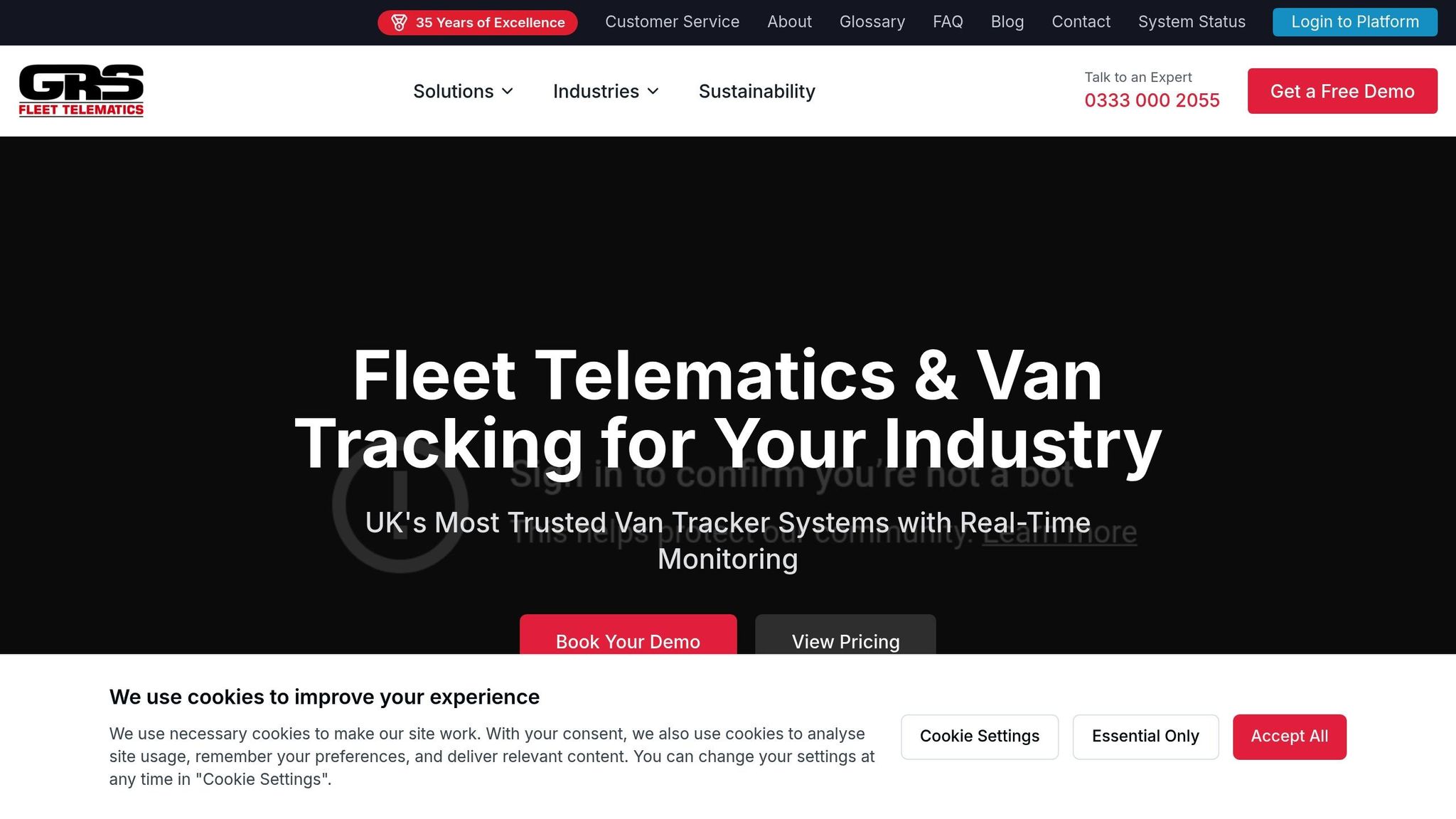API Security Best Practices for Fleet Management
Explore essential API security practices for fleet management to safeguard sensitive data and ensure compliance with UK regulations.

APIs are at the core of modern fleet management, connecting systems like GPS tracking, maintenance tools, and dispatch software. But with this connectivity comes risk. Poor API security can lead to data breaches, vehicle theft, and compliance failures. Here's what you need to know:
- Key Risks: Weak authentication, unencrypted data transmission, and lack of monitoring are common vulnerabilities. These issues can expose sensitive data like driver details, vehicle locations, and operational records.
- Security Measures: Use OAuth 2.0, enforce TLS 1.2+, implement role-based access control (RBAC), and monitor API activity with advanced tools. Regular penetration testing and maintaining an API inventory are also critical.
- Compliance: Meeting UK GDPR and data protection standards is non-negotiable. Encrypt sensitive data, log all API interactions, and limit data access to what's necessary.
For example, GRS Fleet Telematics uses dual-tracker technology and secure APIs to protect fleet data, achieving a 91% recovery rate for stolen vehicles. Their approach includes mTLS, OAuth 2.0, and robust access controls, all starting at £7.99/month.
Takeaway: To protect your fleet, prioritise strong authentication, encrypted communications, and continuous monitoring. These steps not only safeguard operations but also ensure compliance with UK regulations.
Ensuring API Security in Connected Vehicles - DevConf 2025

Common API Security Threats in Fleet Management
Fleet management APIs are increasingly targeted by sophisticated threats that can jeopardise sensitive data and disrupt operations. Protecting your fleet's digital infrastructure and adhering to UK data protection regulations requires a solid understanding of these vulnerabilities. Below, we dive into the key risks affecting fleet management APIs.
Weak Authentication and Authorisation
One of the most pressing issues in fleet management systems is inadequate authentication. Many APIs rely on static keys or long-lived tokens, which create significant risks. If authentication measures fail, attackers can gain unauthorised access to critical fleet operations. This could allow them to track real-time vehicle locations, analyse driver behaviour, or even interfere with vehicle control systems. In severe cases, hackers might immobilise vehicles, monitor fleet movements, or steal sensitive customer data.
The problem doesn't stop at authentication. Poor authorisation controls often fail to enforce the principle of least privilege, leaving systems unnecessarily exposed. For example, a dispatch application might be granted access to route and driver data that it doesn’t need. This lack of Role-Based Access Control (RBAC) opens the door to misuse or exploitation.
Compounding the issue is the integration of multiple systems, such as fleet management platforms, dispatch software, electronic logging devices (ELDs), maintenance tracking tools, and accounting systems. Each integration point can introduce authorisation gaps if access isn't tightly controlled. These gaps create vulnerabilities that attackers can exploit, especially when permissions exceed what a specific role or application requires.
Unencrypted Data Transmission
The transmission of sensitive data without encryption is another major vulnerability. Fleet management APIs handle a wealth of critical information, including GPS coordinates, driver data, ignition statuses, and vehicle usage patterns. When this data is sent without encryption - such as through unsecured channels lacking TLS - it's susceptible to interception. Attackers could exploit this to monitor fleet movements, predict delivery schedules, or even plan vehicle thefts.
Many organisations also fail to enforce HTTPS and HTTP Strict Transport Security (HSTS), leaving communication channels open to potential attacks. Additionally, sensitive data stored without proper encryption creates an extra layer of risk, offering attackers another avenue to exploit.
Poor Monitoring and Logging
A lack of robust monitoring is a common issue that allows threats to go undetected for extended periods. Many fleet management companies struggle with significant gaps in API monitoring, making it hard to identify unauthorised access or unusual system activity. Signs like unexpected errors, slowdowns, or incorrect data displays often go unnoticed until substantial damage has already been done.
Another critical oversight is the failure to maintain a complete inventory of APIs. Many organisations overlook legacy endpoints from older integrations, leaving unsecured access points that are easy targets for attackers. Without a comprehensive API inventory, these vulnerabilities often remain hidden.
Effective monitoring also requires detailed audit logs and advanced behavioural analytics. Without them, recognising patterns of abuse - such as data scraping or unauthorised access - is nearly impossible. This lack of visibility not only delays forensic analysis but also complicates compliance with UK data protection standards.
As fleet management evolves, particularly with the rise of electric vehicles, organisations must collaborate with IT teams to identify all API connection points. Whether it's modernising outdated APIs with stronger security measures or decommissioning unused endpoints, addressing these vulnerabilities is essential before moving on to implementing the security measures discussed next.
How to Secure Fleet Management APIs
Understanding the risks to fleet management APIs is only half the battle. To protect your fleet data from unauthorised access and comply with UK data protection standards, robust security measures are non-negotiable. Implementing strong authentication, encrypted communications, and thorough monitoring can significantly reduce vulnerabilities.
Proper Authentication and Authorisation
Effective API security starts with strong authentication. Using OAuth 2.0 with mutual TLS (mTLS) is a reliable approach, as it employs short-lived signed JWT tokens to minimise exposure risks. Additionally, enforcing the principle of least privilege ensures that each API token provides only the access needed for specific roles.
To systematically enforce these restrictions, consider role-based access control (RBAC) or attribute-based access control (ABAC). These methods limit the potential damage caused by compromised credentials. For particularly sensitive operations - like accessing driver details or controlling vehicles - multi-factor authentication (MFA) should be mandatory. Adopting Financial-grade API (FAPI) standards, already in use by UK Open Banking institutions, adds an extra layer of encryption and identity control, strengthening overall security.
Encrypted Data Transmission
All API communications should use TLS 1.2 or higher, combined with certificate pinning and, when necessary, message-level encryption (e.g., JWS/JWE). These measures ensure data integrity and confidentiality, even beyond basic transport security.
Enabling HTTP Strict Transport Security (HSTS) is another essential step. It forces secure connections and prevents downgrade attacks, which is especially important for fleet systems managing real-time tracking or emergency communications.
While authentication and encryption secure access and data in transit, continuous monitoring is key to identifying and addressing potential issues quickly.
Regular Monitoring and Security Testing
To detect suspicious activity early, runtime monitoring tools should log all API interactions. Integrating behavioural analytics with Security Information and Event Management (SIEM) systems helps identify unusual access patterns and respond swiftly.
Regular penetration testing and vulnerability scanning are equally important. These tests should evaluate authentication processes, authorisation controls, data handling methods, and input validation. Automating these scans within CI/CD pipelines ensures that security remains a priority throughout development. Keeping an updated inventory of all APIs also helps eliminate risks tied to outdated or unused endpoints. Automated certificate management and regular secret rotation further reduce human errors and ensure credentials stay current.
An example of these principles in action is GRS Fleet Telematics, which employs advanced security measures that meet UK data protection standards while delivering reliable tracking solutions. Their approach demonstrates how robust security can coexist with effective fleet management.
GRS Fleet Telematics API Security Features

GRS Fleet Telematics takes security seriously, offering a suite of features designed to protect UK fleet operators while ensuring smooth operations and compliance with regulations.
At the heart of its security strategy is the dual-tracker system, which adds an extra layer of protection for vehicles. This setup includes a primary hardwired GPS tracker - professionally installed and powered by the vehicle's electrical system - and a hidden Bluetooth backup tracker that operates independently. Together, these trackers provide redundancy, ensuring continuous monitoring and enhanced security. When combined with secure APIs, this system offers real-time alerts and has contributed to an impressive 91% recovery rate for stolen vehicles across the UK.
The platform also includes secure immobilisation APIs, allowing authorised users to remotely disable vehicles if theft or unauthorised use is detected. These APIs use strong authentication protocols and role-based access controls, ensuring that only verified personnel can execute such commands. When paired with the tracking system, this feature enables a swift and effective response during security incidents.
To protect API communications, GRS Fleet Telematics employs mutual TLS (mTLS) and OAuth 2.0. mTLS ensures both the client and server authenticate each other using digital certificates, reducing the risk of unauthorised access and token replay attacks. OAuth 2.0 provides scoped authorisation, allowing applications and users to access only the data they are permitted to view or modify. This approach not only aligns with UK security standards but also meets emerging requirements such as Financial-grade API (FAPI).
How to Integrate Securely with GRS Fleet Telematics
Secure integration starts with API key registration and management, where businesses are issued unique credentials with strictly defined access controls. This ensures that access is limited to what is necessary, following the principle of least privilege.
Mutual TLS authentication involves generating and installing client certificates to establish a secure, verified connection between your systems and the GRS platform. Regular certificate rotation and audit logging further strengthen security.
With OAuth 2.0 configuration, organisations can assign different levels of access based on user roles. For instance, fleet managers might have full access to tracking and reporting tools, while drivers could be limited to viewing specific vehicle details. Additionally, geofencing capabilities allow businesses to set virtual boundaries, triggering alerts when vehicles cross these zones via secure API endpoints.
Integrating the remote immobilisation feature requires careful planning to balance security with operational needs. Typically, this functionality is restricted to senior management or security teams, with comprehensive audit logs tracking every activation to ensure accountability and prevent errors.
Meeting UK Data Protection Standards
GRS Fleet Telematics is built to comply with strict UK data protection regulations, including GDPR and the Data Protection Act 2018. All communications are secured with TLS 1.2 or higher, and sensitive data is further protected with message-level encryption. Data stored on the platform is equally safeguarded, ensuring the security of fleet information at all times.
The platform also incorporates detailed access controls and audit logging, which record timestamps, user identities, and the purpose of every data interaction. This not only supports effective security monitoring but also helps businesses demonstrate compliance with UK regulations.
To align with data minimisation principles, API endpoints are designed to provide only the information required for specific tasks. For example, location tracking APIs can be configured to share general area details instead of precise coordinates when detailed data isn’t necessary.
GRS Fleet Telematics also has robust processes to handle data subject rights, such as managing access requests, data portability, and erasure requests. This ensures businesses can respond efficiently to regulatory demands.
All of these features are offered at a highly competitive price, starting from just £7.99 per month, proving that strong security and regulatory compliance can be both effective and affordable.
Summary: Protecting Your Fleet Management APIs
Safeguarding your fleet management APIs requires strong authentication, encrypted data transmission, and consistent monitoring. Key steps include using OAuth 2.0 with multi-factor authentication, enforcing HTTPS for all data transfers, and keeping a complete inventory of APIs alongside regular security testing.
Without proper API security, UK fleet operators face risks like vehicle theft, data manipulation, and breaches of sensitive customer information. These vulnerabilities can lead to operational disruptions, financial losses, reputational harm, and failure to meet regulatory requirements.
Strong authentication and encryption form the foundation of API security, but continuous monitoring is what ties it all together. Monitoring tools can detect unusual access patterns, allowing for a quick response to potential breaches. They also help maintain detailed audit trails, which are essential for compliance and accountability.
Compliance with UK data protection laws, including the Data Protection Act 2018 and UK GDPR, is non-negotiable. These regulations mandate technical and organisational measures to protect personal data, such as encrypting sensitive information and keeping comprehensive access logs. Secure platform solutions can simplify compliance by offering built-in tools that meet these standards.
Instead of developing custom API solutions, using secure, established platforms is a practical alternative. This approach minimises the risk of misconfigurations, ensures regular updates to address new threats, and provides built-in recovery capabilities. It also helps businesses meet regulatory requirements while benefiting from proven security measures.
A great example of this approach is GRS Fleet Telematics. The platform combines advanced security features - like dual-tracker technology, encrypted data transmission, and strict authentication protocols - with practical fleet management tools. These measures contribute to a 91% recovery rate for stolen vehicles, showing that robust security doesn’t have to come at an overwhelming cost for UK businesses.
To maintain API security in the long run, experts recommend regular penetration testing, automated security scans, and routine updates of credentials and certificates. By prioritising these measures and integrating with secure platforms, businesses can protect their assets, ensure operational continuity, and maintain customer trust. Together, these steps create a solid security framework for effective fleet management.
FAQs
What are the best ways to secure APIs in fleet management systems?
To safeguard APIs in fleet management systems, prioritise encryption, authentication, and secure data handling. Encryption ensures that sensitive data stays protected during transmission, making it unreadable to unauthorised parties. Strong authentication methods, like API keys or token-based systems, confirm the identities of users and devices accessing the API. Secure data handling includes keeping software up to date, actively monitoring for vulnerabilities, and adhering to best practices for data storage and processing.
GRS Fleet Telematics provides advanced van tracking solutions featuring dual-tracker technology and an impressive 91% recovery rate for stolen vehicles. With pricing starting at just £7.99 per month, it’s a dependable and cost-effective option for businesses throughout the UK.
What steps can fleet management companies take to comply with UK data protection laws when using APIs?
To align with UK data protection laws when working with APIs, fleet management companies need to prioritise robust security practices. Here are some essential steps to consider:
- Employ encryption to safeguard data during transmission and while stored.
- Use secure authentication methods to ensure only authorised users can access sensitive systems.
- Maintain secure data handling procedures to minimise risks of unauthorised access or breaches.
By focusing on these practices, businesses can better protect sensitive data and stay compliant with regulations. GRS Fleet Telematics contributes to this effort by offering advanced dual-tracker technology, which strengthens vehicle security and aids in recovery if theft occurs.
What risks can arise from neglecting API security in fleet management systems?
Neglecting the security of APIs in fleet management systems can have serious repercussions. Unauthorised access to sensitive information - like vehicle locations, driver details, and operational data - could leave your fleet and business vulnerable to theft, fraud, or even misuse.
On top of that, weak API security opens the door to cyberattacks, such as data breaches or service interruptions. These incidents can lead to financial losses, harm your reputation, and expose you to legal consequences for failing to safeguard customer and business data. Implementing strong API security measures - like encryption, authentication protocols, and secure data handling practices - can go a long way in reducing these risks.
